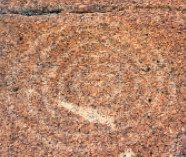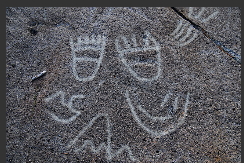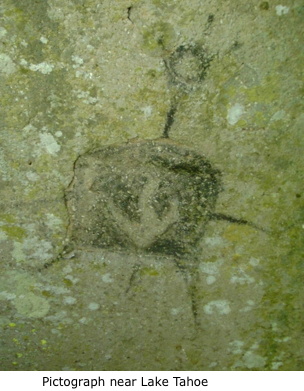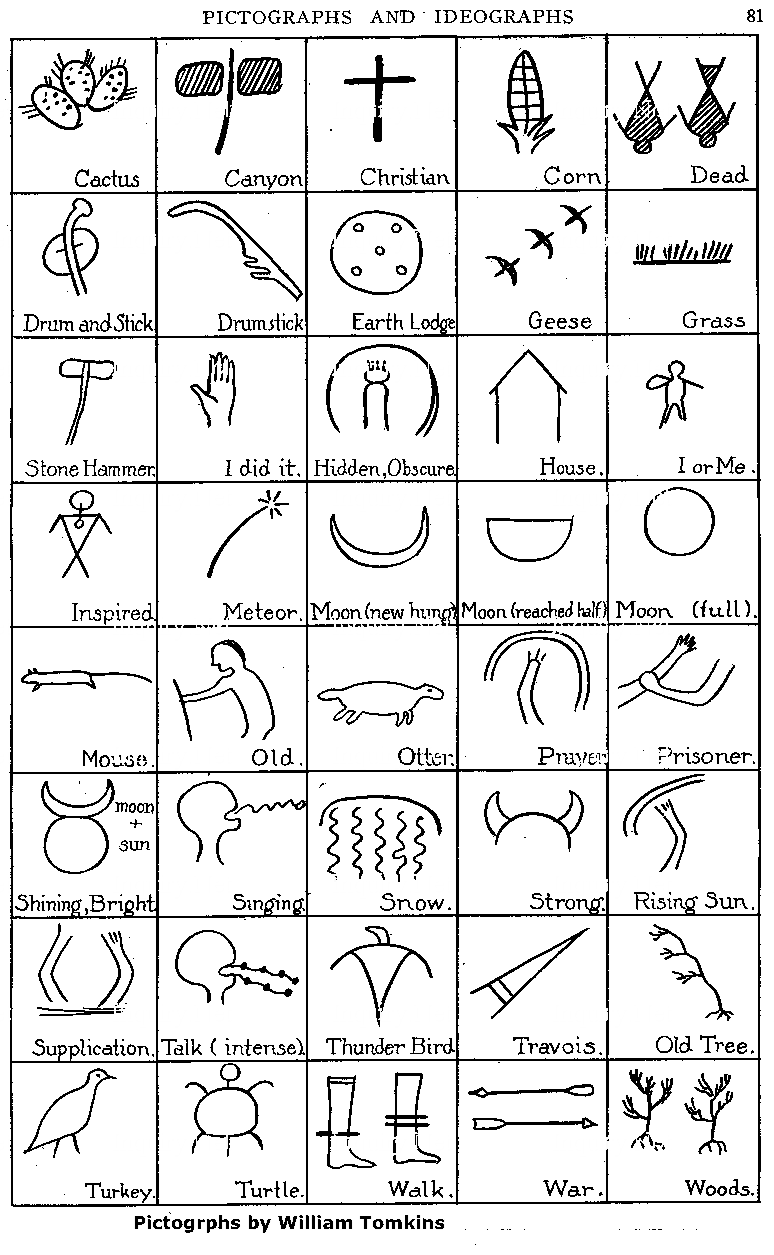
Park at the China Wall parking area around the bend 1/4 mi. from the bridge.
In 1966, Louis A Payen completed a comprehensive inventory and analysis of prehistoric rock art in California's northern Sierra Nevada. This outstanding study identified 133 rock art sites, classified into two major groupings or traditions, Pit-Groove and Abstract-Representational. The two groups were further subdivided into seven separate categories or styles - each defined by a group of attributes and associations.

ExploreDonnerSummit.com SierraTravler.com
Style 7 (High Sierra Abstract-Representational) (Donner Pass - Site CA-NEV-5) These are distinctive petroglyph panels on bedrock surfaces in the higher elevations of the northern Sierra Nevada. Style 7 rock art panels are more complex and contain a greater variety of design elements than any other prehistoric rock art style in the northern Sierra Nevada region, and although considerable variation exists in design elements, there is also an underlying rigidity. Common designs include concentric circles, simple circles elaborated by line elements, wavy lines of varying complexity, tracks, and anthropomorphic-zoomorphic representations. Payen defined Style 7 rock art using a sample of 13 sites, and described it as the most distinctive style of the seven. He suggested that the track element may be diagnostic for Style 7, occurring at 11 of his 15 sites.
The majority of Style 7 petroglyph elements are abstract, consisting of circles, wavy lines, zigzags, and arrangements of these elements into complex designs. We analyzed two of the more naturalistic and readily recognizable petroglyph elements, the bear track, and the anthropomorph (human stick figures).
Evidence (location and chipped-stone lithics [tools] found nearby) supports the hypothesis of an association between these sites and the Martis Archaeological Complex. This evidence is fairly pervasive and argues for the placement of this style of rock art firmly within the Middle Archaic time period, from 4,000 to 1,500 B.P. which has been equated with the Martis Complex.
Source: Ancient Petroglyphs of the Northern Sierra Nevada, Daniel G. Foster, 2009
Senior State Archaeologist,
California Department of Forestry and Fire Protection (CAL-FIRE),
On a backpack trip in 2010 a local guy showed us a turtle like pictograph near Tahoe.

The nearest thing I could find on the web was a turtle like pictograph near Quaaout Lodge in south-central British Columbia.
Turtles do seem to be a common pictograph.

Source: Indian Pictographs: Sioux Ojibway Pictography Ideography, Native American Petrographs, Picture-Writing North America
Books:
Great Basin Rock Art: Archeological Perspectives
By Angus R. Quinlan, editor
Indian sign language - William Tomkins - Google Books
Links:
CAL FIRE Archaeology Program: Abstract-Representational Petroglyphs of The Northern Sierra Nevada, California by Daniel G. Foster,
Senior State Archaeologist,
California Department of Forestry and Fire Protection (CAL-FIRE),
March 12, 1999
The Association of Style 7 Rock Art and the Martis Complex in the Northern Sierra Nevada of California, Foster, Betts, Sandelin - 2005
Native American Symbols
Ancient Petroglyphs of the Northern Sierra Nevada, Foster, 2009
Martis people - Wikipedia
Nevada Rock Art Foundation
Friends of Sierra Rock Art: New Perspectives in Rock Art Research | YubaNet.com
Books - Papers:
Ancient Rock Carvings of the Central Sierra: The north Fork Indian Petroglyphs, 1984, Willis A Gortner
Prehistoric Rock Art of California, 1978, Heizer and Clewlow
"Four Rock Art Studies", 1978, Ed. C. William Clewlow Jr.
Other:
Society for California Archaeology: Proceedings by Region